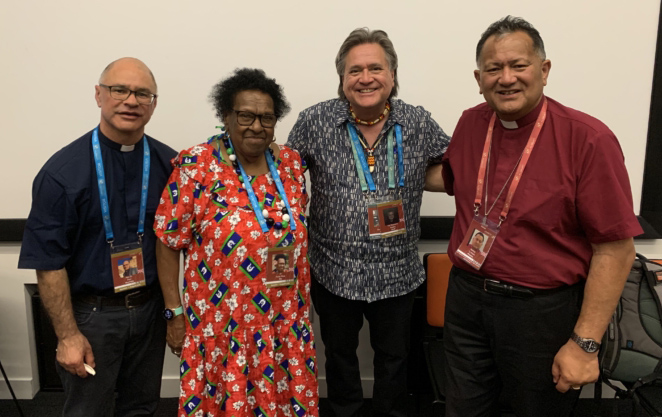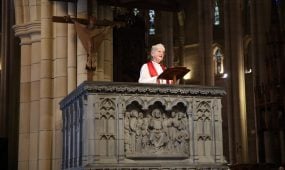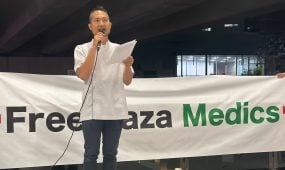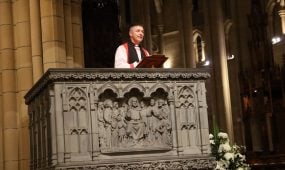Anglican Indigenous Network: Lambeth Conference 2022
Homilies & Addresses
“God calls us to respect one another. This, in part at least, involves respecting people’s territories, traditions and protocols; seeking counsel and consent; and, caring for one another. Respect is also about being welcoming and inclusive. When respect is fostered, harmony presides. When respect is denied, harm is caused,” says Aunty Dr Rose Elu in her Lambeth Conference Anglican Indigenous Network address

Good afternoon,
My name is Aunty Dr Rose Elu. My people are from the beautiful island of Saibai in the Torres Strait Islands, which are located between the north of Australia and Papua New Guinea.
I acknowledge and thank the people of Canterbury for welcoming me to their land. I bring with me the blessings of my ancestors from the Torres Strait. I am proud to represent the First Nations peoples of Australia here today.
As is customary, I would like to greet you all in my language.
Mina kapu bathaynga mura ngithamulpa.
Good morning to you all.
Ina ngalpa garwoeydhamin nabi maygi boeradhanu.
For us to gather here at this holy place.
Ngalpa lake eso manin Awghadhapa nabi goeygipa
We give thanks to God for this day.
Ubilnga matha kedha ngitha ngurpemin ngoeymun igililmaynu a.
I would like you to learn our cultural way of life.
Pudhamin mura ngalpalpa ngulaygoepa yananab
So that each and every one of you understand.
Today I would like to share with you about four interrelated key things that are important to my people. These are Reconciliation between Indigenous and non-Indigenous Australians; the Coming of The Light, of the holy Bible, to my people in 1871; damage to the climate; and, a forthcoming referendum about an Indigenous Voice to Parliament enshrined in the Australian Constitution.
Very broadly speaking, there are two main ethnic groups of Indigenous peoples from Australia. These are the Aboriginal peoples who comprise hundreds of discrete Nations from the mainland and surrounding islands, such as Tasmania in the south. And, Torres Strait Islanders, like myself, who are ethnically Melanesian and from islands in the Torres Strait in Australia’s north. People from each Aboriginal Nation and across the Torres Strait Islands speak different languages and celebrate diverse cultures.
Advertisement
We do, however, have many things in common, including a history of colonial oppression; respect for others’ protocols, traditions and lands; cultures of caring for one another; respect for God’s good creation; and, strong oral traditions.
Children love to hear their parents and grandparents tell them stories. When I was young my father, who was a Saibai chief, would gather his children around him and tell us stories. One of the stories my father told his children was about the migration of my people from Saibai in the far western group of the Torres Strait Islands to the Aboriginal Nations of the Gudang and Yadaykhenu on the Northern Peninsula Area of the state of Queensland.
In the late-1940s, my people needed to migrate to seek safety from the threat of tsunami and malaria. We believe that God spoke into the hearts of our Elders and led them to the First Peoples of the peninsula, including to the Gudang and Yadaykhenu peoples.
My father and other Saibai Elders understood that in order to move to another people’s territory that they had to seek their consent and negotiate the way with them. So, my father, along with other Elders, went to the peninsula in Far North Queensland one night to do this, bravely breaching a police-enforced curfew.
Advertisement
He was met on the beach by the peninsula’s First Peoples who were waiting to welcome an unknown arrival. Somehow the Holy Spirit had spoken into their hearts and directed them to the beach to wait for and welcome our Elders who arrived by lugger.
Even though the Queensland Government drew up boundaries ahead of my people’s arrival without the consent of the peninsula’s Traditional Custodians, we knew that we had to seek permission from the Custodians and respect their protocols before we migrated. They welcomed my people graciously and we live together harmoniously to this day.
Before my mother, my siblings and I joined him, my father lived in an old army hut in Seisia on the peninsula. Ahead of building what was to become our new home, he went to the peninsula’s First Peoples to seek their counsel about what particular trees would be best for building and he sought their permission to cut some down. They then showed him some trees between two hills. My father then set about building a house by hand for my family – Dad, Mum and 10 young folk. This involved moving a lot of very heavy timber.
So my father and his brothers built a raft out of recycled 44-gallon fuel drums to move the timber because it was easier to move it from one end of the coast to another rather than by land. The make-shift rafts were pulled by ropes attached to dinghies, which were powered by oars. They then used a wagon that they had built to take the timber the rest of the way over land. The wagon was pulled by my father and his brothers using ropes. By the time Mum and we siblings came, my father and his brothers had built a seven bedroom home with a wraparound verandah.
I have vivid memories being welcomed by the Gudang and Yadaykhenu peoples. They became like adopted family to me. As an Elder, I now gather my grandchildren and grandnieces and grandnephews around me and tell them stories. This is one I like to tell them.
When I was about six or seven, my father and uncles set sail in a small dinghy from Seisia to Thursday Island. We were not far from Seisia when our boat capsized in the waves. As I couldn’t swim yet, my father and uncles passed me from one to another to get me safely to shore. They then carried me to the village in Seisia where my adopted Aboriginal grandma and grandpa rubbed my legs with goanna lizard oil to strengthen my exhausted limbs. It was common for my adopted Aboriginal family to lovingly care for us all with bush medicine when we were sick or injured.
God calls us to respect one another. This, in part at least, involves respecting people’s territories, traditions and protocols; seeking counsel and consent; and, caring for one another. Respect is also about being welcoming and inclusive. When respect is fostered, harmony presides. When respect is denied, harm is caused.
However, harm can be healed through reconciliation. The dictionary tells us that the etymology of the term “reconciliation” stems from the Latin “re”, which means “back”, and “conciliare” which means “bring together”.
2 Corinthians 5.18-20 tells us that:
“All this is from God, who reconciled us to himself through Christ and has given us the ministry of reconciliation; that is, in Christ God was reconciling the world to himself, not counting their trespasses against them, and entrusting the message of reconciliation to us. So we are ambassadors for Christ…”
The Bible thus tells us what it means to be reconciled to God as ambassadors for Jesus. And, we are also told that God has given us the ministry of reconciliation – of bringing back together. So reconciliation is sacred ground indeed.
In Australia, churches, especially Aboriginal and Torres Strait Islander clergy and Elders, are leaders when it comes to Reconciliation between First Nations peoples and non-Indigenous Australians. For example, the annual National Reconciliation Week started as the Week of Prayer for Reconciliation in 1993 during the International Year of the World’s Indigenous Peoples. Today National Reconciliation Week is celebrated in workplaces, schools and childcare centres, community organisations, and by individuals Australia-wide.
For meaningful Reconciliation with First Peoples to happen in our churches, as part of this “bringing back together”, Australians from all walks of life are gathering to share stories about our histories and spiritualities. This is another story I like to share.
I was not the best with sailing growing up, especially given that I am from the sea. I suffered terrible seasickness as a child. Whenever we sailed, I would always stay on deck, close to my father so I felt safe. Once when my family was out sailing in a lugger, I saw a huge rainbow at the back of Thursday Island, about 40km from the Queensland mainland. I pointed at the rainbow and remarked about the beautiful colours to my father. He asked me to go and gather my brothers and sisters who were below deck. As we sat around my father while he steered the rudder, he told us that, “The rainbow is God’s creation and God made this world in beautiful colours, including his people.” He then told us not to be judgmental and to always respect, honour and listen to one another. He said that loving others is always the most important thing.
As well as National Reconciliation Week, another key date in the Anglican Church of Australia’s calendar is the Coming of The Light. I’d like to share with you some of what this very special date means for Torres Strait Islander peoples.
Last year we celebrated the historic 150th anniversary of “The Coming of The Light”, commemorating the date that the London Missionary Society and Melanesian Christian leaders landed on the Torres Strait Island of Erub, introducing the Bible there. Following this, we ceased tribal warfare and other cultural practices after learning and understanding what it means not to take someone’s life.
It is important for all Anglicans to appreciate that Jesus was present in my people before the Bible – before the Light of the Gospel – came to the Torres Strait Islands on that special day in 1871. Our spirituality lies in the land, sea and sky and since time immemorial our people have believed in a Creator – we just did not know yet that the Creator was the Christian God. As the custodians of the land, sea and sky, my people had already conceived that there was a Creator God before the Bible came to us.
While the Coming of The Light – the coming of the holy Bible – made this connection for us, we had already received God before the arrival of the English and Melanesian missionaries because Jesus was already with us. So the Coming of The Light commemorates the Gospel coming to us and giving us a name for our Creator, whose image and likeness we are made in.
However, this is not the message that children’s Bibles published in the English language told me when I was growing up. When I was at Sunday School at age 10 or 11, I remember looking at an illustration of Jesus in a children’s Bible. Jesus was pictured as a man with very fair skin and sitting on his knees were very fair skinned children whom he was engaged in happy conversation with. At his feet sat a dark skinned girl who reminded me of me. “Why was Jesus not smiling at and talking with her also?” I wondered. I felt alienated, set apart, distanced by this illustration, rather than welcomed and included. Sharing a story like this takes a spirit of openness and courage. Reconciliation – being willing to “bring back together” – takes a spirit of openness and courage.
We have come a long way in the “bringing back together” process since this children’s Bible was published.
When I was a teenager living in Seisia on the peninsula, I often asked my older brother who was an Anglican priest and my parents about the Coming of The Light. I did not understand why it was called this – I thought that our people had always been in the light. Their response was, “Yes. That is true. We were always in the light. When the missionaries brought us the light of scripture, the light of the Gospel unified with ours.”
Because our spirituality lies in the sea, sky and land, which are part of God’s good creation, we have an intrinsic connection to the sea, sky and land. We see ourselves as belonging to creation. It is central to our wellbeing. Torres Strait Islanders are seafaring people, so we live off the land and the sea. Our traditional foods, such as taro, yams, cassava, sweet potato, fish and shellfish have always nourished us. These foods are also important culturally because they feature in our ceremonies and celebrations.
There are 17 inhabited islands in the Torres Strait and seven of these are inundated with water due to rising sea levels. My island of Saibai is one of these. Because of damage to the climate, we are finding it increasingly difficult to obtain clean fresh drinking water, natural materials for shelter and land that is safe to live on. Coastline erosion has destroyed gardens of traditional foods and tribal ceremonial sites.
However, it is not just Melanesian people from low-lying islands like myself who are experiencing the daily impacts of a damaged climate. Other Melanesian peoples are impacted. In Papua New Guinea climate-induced droughts since 2015 and early frosts since the 1990s have caused severe food shortages.
I am also told that in the highlands of West Papua groundwater is being contaminated by salt water because of rising sea levels. Frosts and blizzards in the West Papuan highlands have taken the lives of villagers. Weather extremes are impacting food production, including resilient traditional crops, such as sago and taro. Coastline erosion has caused churches and whole cemeteries to disappear into the sea.
As Anglicans we are called “to strive to safeguard the integrity of creation, and sustain and renew the life of the earth.” So as part of my role as an Elder, I lobby the Queensland and Australian Governments for meaningful policy change so damage to the climate can be reversed. I stand in solidarity with other Australians at protests, calling for this meaningful policy change. I also gather with Australian Anglicans in public prayer vigils for an ongoing heart’s conversion towards care for Creation.
Australia recently had a change of Federal Government, with another political party now in leadership. One of the key drivers of this shift is that Australians want meaningful policy change at a national level so that damage to the climate can be reversed. We want our elected representatives to represent us and to safeguard the future of our children and grandchildren.
If we all work together, we can create safe and healthy communities. We see this in the popularity of home solar energy, which has made Australia the most solar country per capita in the world. The state of Queensland, where I live and where my island of Saibai is located in the north, is affectionately known as the “Sunshine State”. In Queensland’s capital of Brisbane where I am based, the streets are lined with solar-roofed houses.
Australia’s First Peoples are well aware of the link between a damaged climate and poor health outcomes. A damaged climate is a key driver of flooding, severe cyclones, heatwaves and bushfires. Such events have serious health related effects, with infectious diseases like rheumatic heart disease and mosquito-borne diseases increasing. The supply-chain of life-saving medications, including for the disproportionate number of First Peoples living with diabetes, is being interrupted. And, socio-cultural, psychological and spiritual distress is also occurring.
However, there is hope. There is hope if the voices of Australia’s First Peoples are heard and acted upon. History tells us this.
On 3 June 1992, the High Court of Australia found that a group of five plaintiffs from Mer, in the east of the Torres Strait, were the island’s Traditional Owners. This decision was momentous – and not just for these five. The case has had a profound impact on the lives of Aboriginal and Torres Strait Islander peoples since and has helped to foster reconciliation between First Nations and non-Indigenous Australians.
Through this Mabo Case, which was named after the first listed plaintiff, the late Uncle Eddie Koiki Mabo, the myth that at the time of colonisation the lands now known as Australia were terra nullius (or “land belonging to no one”) was overturned.
Twelve months after the High Court judgement, the Commonwealth Native Title Act 1993 was passed through Australian Parliament. This Act has enabled other Aboriginal and Torres Strait Islander peoples to make claims based on their ongoing traditional rights to their lands and waters.
Fast forward 25 years and a National Constitutional Convention of Aboriginal and Torres Strait Islander leaders was held in Australia’s centre. At this seminal 2017 gathering, the Uluru Statement From the Heart was signed. The Uluru Statement From the Heart is an invitation to the Australian people to walk with us as a movement for a better future. An Indigenous Voice to Parliament included in the Constitution is the first stage of the Uluru Statement’s reforms. Inspired by the Statement, last year my Diocese of the Anglican Church Southern Queensland made a formal submission in support of the call for this Voice.
In order for the Australian Constitution to be changed, a successful referendum must be undertaken. So ‘From the Heart’, the campaign stemming from the National Constitutional Convention, is calling for a referendum to be held in 2023 on this Voice. Australia’s new Prime Minister has promised to hold a referendum on constitutional recognition in his first term of Parliament.
Importantly, a Voice to Parliament that is included in the Australian Constitution will give all Australians the best chance of finally closing the significant health and life expectancy gap between Indigenous and non-Indigenous Australians.
This is because a Voice to Parliament, included in the Constitution, would enable Aboriginal and Torres Strait Islander peoples to advise Federal Parliament about laws and policies that impact them in a more direct, streamlined and effective way. This means that Aboriginal and Torres Strait Islanders would be included in the law-making process, rather than having politicians and policy makers merely deciding what is best for us.
When Aboriginal and Torres Strait Islander peoples have a meaningful say on issues that affect them, we get better results on the ground in key areas such as health and education. Ensuring this Constitutional guarantee of a Voice will help provide our Indigenous leaders and their communities with stability and longevity, particularly across election cycles and changes of Government.
Whatever model the Voice takes, it is my hope that the First Peoples who form this Voice speak compellingly about the connection between damage to the climate and the health outcomes of First Peoples. The Uluru Statement From the Heart is a gift to all Australians – a roadmap to fairness and meaningful change. So by supporting the Voice, Australians will also take another meaningful step forward towards Reconciliation.
Let us Pray.
This “Prayer of The Light” was made by one of the former Bishops of the Diocese of North Queensland, the late Bishop Eric Hawkey.
O’ Christ the light of the world
We thank you that your light shines among us
Draw us ever closer to you
So that free from sin
We may show forth the light of you glory in the world.
Amen.
Editor’s note: The Season of Creation starts on 1 September on the World Day of Prayer for the Care of Creation and ends on 4 October, which is the Feast Day of St Francis of Assisi. To find out about local Season of Creation events, please keep an eye on the anglican focus Events page.





